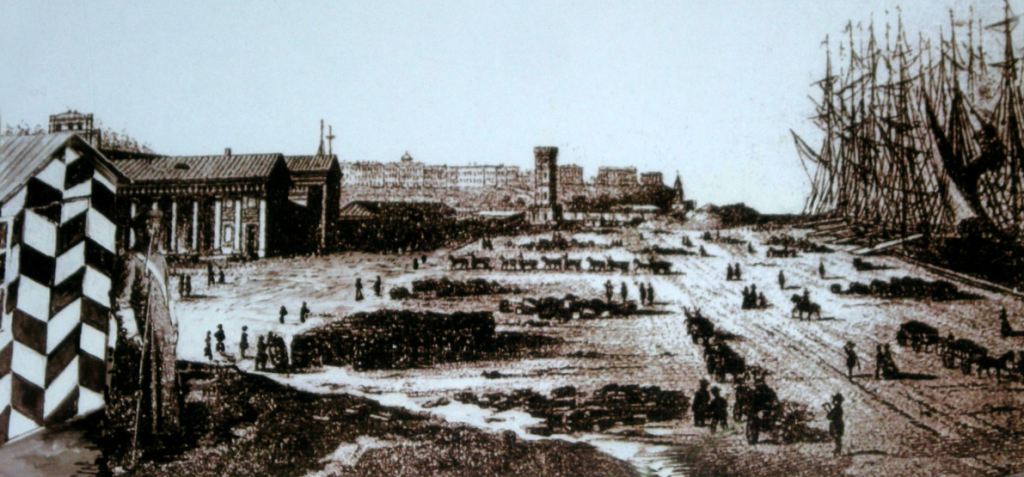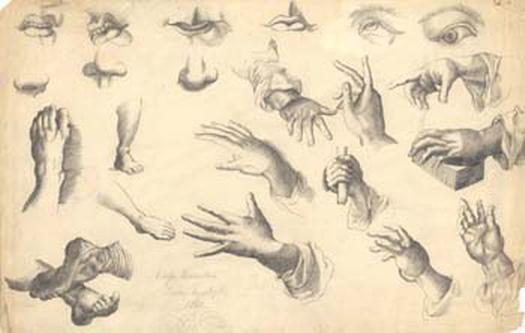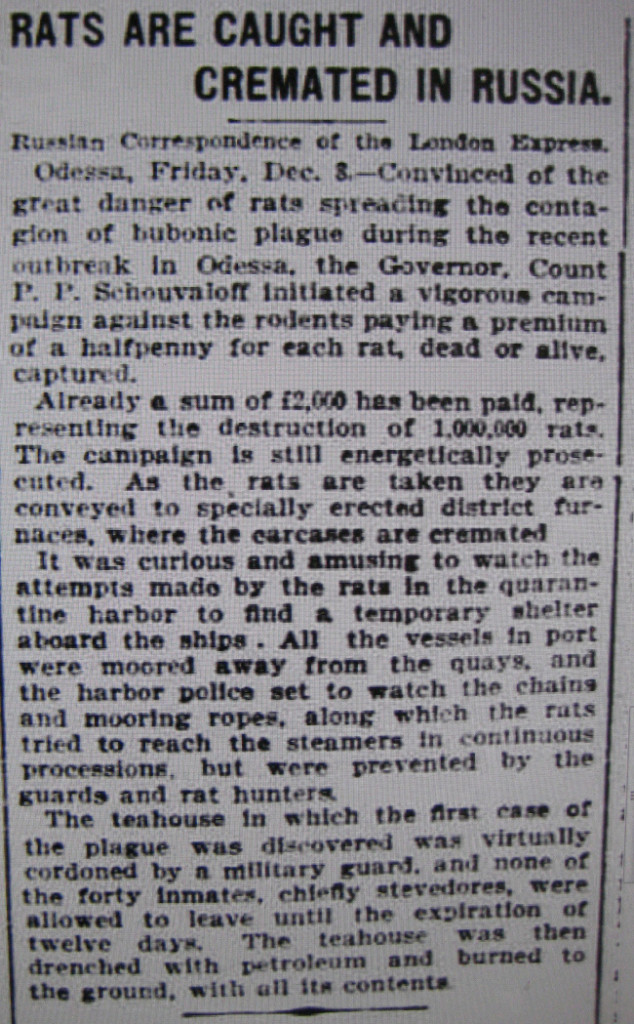One of Europe’s last major epidemics of the bubonic plague devastated the city of Odessa. A look (way) back at a time of unprecedented paranoia, mass quarantine, corrupt plague-profiteers and 19th century debauchery reveals we haven’t learned very much from crises past. Sailors could see the plague flags flying above Odessa’s port while still out at sea. A yellow flag meant purification; a red flag meant the Black Death had already arrived. These seafarers, many arriving fresh from the crowded slave markets of Constantinople, had heard rumors about the appalling conditions crews of other ships had encountered in the quarantine of the barren port city on the other side of the Black Sea.
The crew of every foreign vessel that arrived in Odessa was forced to endure a period of confinement inside the city’s quarantine quarters. Guards armed with loaded muskets surrounded the grounds at all times, and anyone who attempted to escape before they were cleared was shot dead on the spot. In 1839, the Lancet called Odessa’s Lazaretto, which opened at the beginning of the 19th century, “one of the severist [sic] in the world”. The New York Times was harsher in its appraisal in 1854, calling the city’s quarantine “a hateful political tyranny”.
Between 1812 and 1813, the “Black Death” devastated the population of Odessa. It was one of the last catastrophic plague outbreaks in Europe. Before it disappeared, just as quickly as it had arrived, the pestilence had plunged the city and its dreaded cordon sanitaire into a Dante-esque scene of disease, corruption, and 19th century depravity.
The city of Odessa was founded by despotic libertine Catherine the Great in 1794, and soon became the most cosmopolitan in the Russian Empire. The Black Sea settlement rapidly evolved into a seedy El Dorado that drew an assortment of nationalities, including Turks, Tatars, Greeks, Jews, Romanians, Bulgarians, Albanians, Italians, Poles and Moldovans. Catherine the Great also encouraged Russians and Ukrainians from within the Russian Empire to move to Odessa. The city’s population ballooned in size, and quickly gained a reputation for tolerance and openness, two qualities central to Odessa’s claim to uniqueness embodied in the so-called “Odessa myth” — an idealized self-concept tested in times of pogroms and plague.

On November 22, 1812, all 32,000 residents of Odessa were forcibly imprisoned in their homes. The city’s popular governor-general, a Frenchman named Duke de Richelieu, assembled 500 Cossacks to “restrain” the entire population and ensure its complete isolation. “All the exterior marks of friendship were forbidden,” one survivor wrote.
The plague raged with violence and was soon killing up to 40 people each day. No one was permitted to open their windows or doors, except when authorities delivered water-soaked meat and fumigated bread twice a day. Tar-smeared galley-slaves, who were used to spending their servitude rowing ships, were forced to push carts carrying the plague-afflicted through the muddy streets. They raised a red flag when transporting the dying, and a black flag when transporting the dead. Those stricken with symptoms of the plague were labelled “suspected” and taken to special quarantine quarters, where they were forced to dig graves, possibly for themselves.
Odessans spent a total of 66 days confined in their homes before the Duke’s order was lifted. When it was all over, the plague had claimed the lives of 2656 people out of an original population of 32,000 — about one in 12 inhabitants. Among the dead were four of Odessa’s five doctors, who had all fallen ill after caring for the sick. Any houses the dead left behind were set on fire and burned to the ground.

The first quarantine in history was established in 1377, in the Venetian colony of Ragusa, now Dubrovnik, Croatia. Ragusa was a coastal city-state of wealthy traders, and the radical new public health initiative was an attempt to ease the destruction wrought by the bacterial infection, which residents believed was brought by foreign ships. Quarantine turned out to be an effective means of reducing the spread of infection. But this success often came at the neglect of the human or medical needs of those designated “contagious”. Separation of the sick or “suspected” from the well, or the “fit” from the “unfit” has a long and complicated history. A similar process of filtering people, to establish who should and should not be permitted to move beyond boundaries and police cordons, is currently underway at several of Europe’s borders. In Discipline and Punish: The Birth of the Prison, Foucault writes:
The plague is met by order; its function is to sort out every possible confusion: that of the disease, which is transmitted when bodies are mixed together; that of the evil, which is increased when fear and death overcome prohibitions. It lays down for each individual his place, his body, his disease and his death, his well-being, by means of an omnipresent and omniscient power that subdivides itself in a regular, uninterrupted way even to the ultimate determination of the individual, of what characterizes him, of what belongs to him, of what happens to him.
***
There are several stories about the outbreak’s origins, with a predictable cast of culprits. One source claims the pestilence arrived in Odessa when the plague-afflicted crew of an Austrian ship bribed a guard to get out of quarantine, then got drunk and went galavanting through the city’s brandy shops. Others say a Turk escaped quarantine and spread the infection among the “female dancers at the opera”. Another story places the unleashing of the contagion in a romantic context: a contaminated ring, wrapped in cotton wool, was smuggled out of quarantine to “an actress” in town. What is clear from these explanations is that then as now, foreigners and “fallen women” were the easiest scapegoats — even in famously tolerant Odessa.
Depending on who you talked to, Odessa’s quarantine was either a model of medical efficiency, or a symbol of Russian imperial oppression. Arriving at Odessa from Constantinople, all belongings, including clothing, personal letters and journals, were immediately collected by an officer and prepared for fumigation. Items suspected of contamination with the contagion were burned.

New arrivals were made to shed their clothing along with their Victorian shyness. Some men gazed upon the bodies of other men with an interest one might not expect to find in the memoirs of a 19th century “gentleman adventurer”. The 1833 travel diary of British Admiral Aldolphus Slade contains an intimate recollection of his preliminary health inspection:
The individual commences his quarantine in puris naturalibus. He strips naked in the presence of the director and the surgeon of the Lazaretto, and having passed their inspection, puts on clothes, supplied either by a friend in pratique, or hired from the spenditore, and wears them till his own garments are smoked. I expressed as an Englishman a natural reluctance to submit to such exposure…
My medical companion was then introduced, and as no scruples were supposed in him, similar forebearance was not observed. Either being used to the occurrence, or not caring about it, he exhibited the beauties of his person very leisurely. He was a short, fattish man, whose appearance in the primitive guise, before Sin begat Shame, might have tickled anybody’s fancy. The inspecting officer smiled. I could not help committing myself more openly, for he appeared precisely we may presume Mr. Pickwick’s figure to have been, when about to indulge in a bath.
Next came the German watchmaker and the Jew. The son of Levi was shy, but his scruples were unheeded, and he was bid to extend his arms. Lastly, our soldier guardian walked in. He did not care about the affair. He threw off his clothes with military promptitude, and stood upright, — a figure for a sculptor to have gazed on with pleasure.
The sight of the Russian soldier’s body may have impressed Mr. Slade, but accommodations in quarantine apparently resembled a dungeon. The collected letters of one Rev. Dr. Pinkerton of the British and Foreign Bible Society dated 1819 offer a detailed account of the sleeping quarters:
The cell which I occupy is 16 feet by 13: I found it very damp and cold when I first entered it, and containing nothing but two old wooden bedsteads, and a small dirty table, and swarming with rats, mice, fleas, and other vermin. However, I procured some firewood with part of which I filled up the holes in the floor, and bottom of the walls, and with the rest heated my brickstove, every day, so that during the last two days I have been left in quiet to sleep upon my straw; for it was several days before I succeeded in keeping out the rats and mice.
Dr. Meissner, a German physician, put it succinctly: “The whole scene forcibly reminded me of the lines of Dante.” Meissner then quoted the following passage:
“Here sighs, with lamentations and loud moans,
Resounded through the air pierced by no star,
That e’en I wept at entering.
Various tongues,
Horrible languages, outcries of woe,
Accents of anger, voices deep and hoarse,
With hands together smote that swell’d the sounds,
Made up a tumult, that for ever whirls
Round through that air with solid darkness stain’d,
Like to the sand that in the whirlwind flies.
* * *
I then: Master! What doth aggrieve them thus,
That they lament so loud?
He straight replied: That will I tell thee briefly.
These of death No hope may entertain.”

Why did Odessa adopt a quarantine system so strict that it became notorious across the world? The city’s proximity to Constantinople, where major outbreaks of the plague were recorded throughout the 19th century, undoubtedly contributed to the decision to undertake such severe measures. Odessa endeavored to protect the Russian Empire from the so-called “contagious Turks” by adopting the rigid set of rules.
But some historians suggest that there may also have been another reason quarantine was so tightly regulated: Odessa’s more enterprising residents realized early on that money could be made by exploiting individuals in quarantine. Merchants who sold goods inside the Lazaretto began setting their “quarantine prices” extraordinarily high, well aware that the quarantine’s captives had nowhere else to go. One merchant even paid to renovate the city’s iconic Opera House and promised city officials that he’d bring Europe’s biggest stars of the stage to perform there in exchange for a guarantee that he’d have a monopoly on the quarantine market.
“Just as money could be made off of war, money could be made for the crafty merchants of Odessa from a terrifying epidemic,” writes Elizabeth Abosch, a Russian language instructor at the University of Maryland who maintains a website about the history of Odessa.
The writings of British Admiral Slade certainly make Odessa’s quarantine sound like a slick money-making operation, more like a casino or a cruise ship than closely guarded quarters for the containment of a deadly contagion.
“The Lazzaretto is on a superb scale, containing cafes, restaurateurs, and billiards, to assist the captains and mates in spending their cash,” he wrote.
Even Pushkin commented on the lively commercial life of the quarantine quarters in Eugene Onegin, which he worked on while living in exile in Odessa:
“What novel goods and merchandises
Have now arrived in quarantine?
Have the expected wine casks come?
What of the plague, where conflagration?
And haven’t there been famines, wars,
Or other such-like novelties?”
As the 19th century wore on, the plague grew increasingly uncommon in Odessa, though its persistent horrors still gripped Constantinople, the sick man of Europe. Sometimes reminders of the plague even reached Odessa’s shores in the form of dead bodies: “Some time after the great plague [in Odessa] had ceased, vessels arrived from Constantinople with [the plague] on board, and anchored at the Lazaretto. Frequently all on board died, leaving none to bury them,” one traveler to Odessa wrote in a grim journal entry published in the September 1865 edition of the California Farmer and Journal of Useful Sciences.
Historian Heath Lowry’s account of the infection in the Ottoman Empire suggests that the authorities there responded quite differently to the plague’s arrival: “One might well query what, if any, preventative measures did the Ottomans [post-1517] come up with in an attempt to thwart the periodic ravages caused by the plague? The answer is: none whatsoever.”
The plague continued its death march through Constantinople, the last point of departure for many ships headed to Odessa. The capital of the Ottoman Empire lost 150,000 inhabitants to an outbreak of the plague in 1803. A second epidemic claimed the lives of 100,000 in 1812. Odessa’s response was to adopt prison-like quarantine quarters that had the added benefit of providing local merchants with some extra cash.
The sprawling quarantine harbor and facilities, as well as the small city of Odessa, were visible from the Black Sea. French civil engineer and Knight of the Order of St. Vladimir of Russia Xavier Hommaire de Hell described his trip from Constantinople to Odessa and his first glimpse of the city and its quarantine. “It was, indeed, a European town we beheld, full of affluence, movement, and gaiety,” he wrote. “But alas! Our curiosity and our longings, thus strongly excited, were not for a long while to be satisfied. The dreaded quarantine looked down on us, as if to notify that its rights were paramount.”
This article will be the first in a short series exploring lesser known historical events. If you have any submissions for consideration, please send them to editor@balkanist.net.


